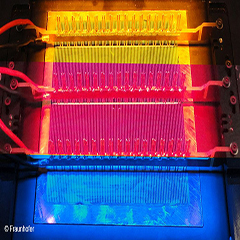Having acquired Fraunhofer Institute as its latest customer, WAVELABS now supplies one of the world’s leading research institutions for photovoltaics. The WAVELABS SINUS-220’s high precision and flexibility were the key factors that influenced Fraunhofer’s decision to purchase the solar simulator.
The Fraunhofer Center for Silicon Photovoltaics (CSP) uses state-of-the-art equipment to conduct analyses and applied research at the forefront of solar module technology. With its new SINUS-220 solar simulator from WAVELABS, the renowned German research institution now has access to the best simulation of the sun available.
Dr. Christian Hagendorf’s diagnostics team at Fraunhofer CSP uses solar simulators as a tool for testing and optimizing PV cells. Depending on the manufacturer and cell, different technologies and varying spectral sensitivities come into play. “For a proper analysis that ensures equivalency with other measurements, not only must we be able to simulate the sun with precision, we also need to be able to modify the spectrum emitted. This way, we can be sure we’re getting an accurate measurement,” said Hagendorf.
The full integration of infrared and electroluminescence cameras in the SINUS-220 also simplifies Dr. Marko Turek’s work at Fraunhofer CSP. His team evaluates the electrical characteristics of PV cells, which involves examining correlations between material quality and efficiency as well as hot spot resistance. The LED technology developed for the SINUS-220 also allows the operator to measure high-efficiency solar cells over very long exposures. “We can adjust the exposure time as required, which is a huge advantage over conventional flash- based measurement systems,” explained Turek. The LEDs also allow for a wide range of variable intensities. “The result is that we are able to perform with great speed and precision a number of complex measurements that allow us to generate our research findings here at Fraunhofer CSP.”


























